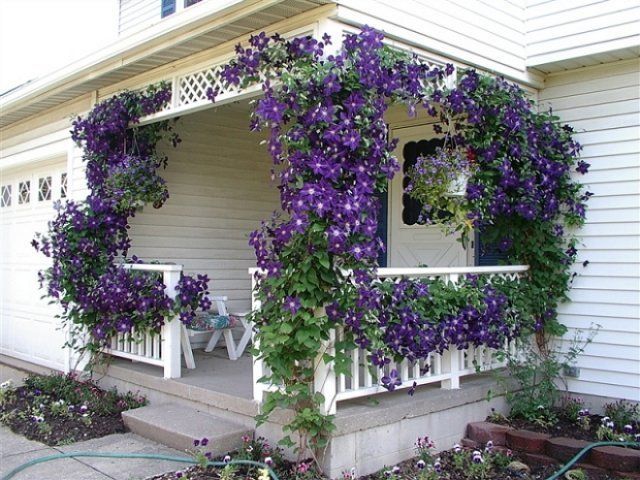
To decorate a summer cottage, you can use not only garden beds and flower beds, but hedges decorated with flowers, fences and nets. Any, even the simplest element, can be given colors; it’s beautiful enough to beat it with a floral arrangement. Climbing plants are often used to create landscape projects. The stem is elastic and flexible, which allows you to wrap around any object. Plants are blooming or forever green, annual and perennial.
Content
Perennial plants for the gazebo
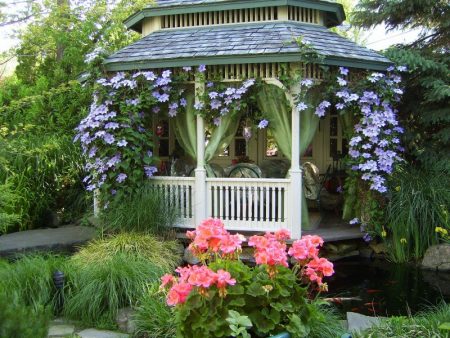
Although perennial vines grow longer than annuals, they easily tolerate frosts and cold winters, and from the beginning of spring turn green again or gain color. In flowering species, flowering occurs to a lesser extent than in annuals, but lasts annually for 3-8 years. Perennials do not need to be replaced, and in southern regions with a warm climate, lianas grow and bloom on their own. When grown in other regions, they need care. It is determined depending on the type of vine.
Wild grapes
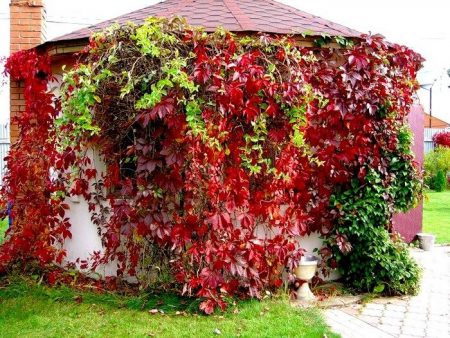
If you do not want to constantly look after the crop, it is better to plant wild grapes or, as it is called most often, girlish. For hundreds of years, grapes continue to adorn fences, balconies, and terraces of the south. Vines are decorated with smooth green leaves, and in the summer fruiting begins with black berries. Creating a real vineyard on the site will give the cottage a special charm and will attract the attention of everyone around.
Culture has several advantages:
- not afraid of frost;
- does not require pollination for the formation of berries;
- growing very fast;
- can be grown both in the sun and in the shade;
- not sick;
- breeds well.
Planting grapes is very simple. There are no special requirements for land; it grows even in poor soil. The seedling is planted in a hole and sprinkled with earth, then watered. As soon as the grapes begin to grow actively upwards, part of it is attached to a high fence or arbor. After a year, berries form on the branches. They are not suitable for food, but have an unusual beautiful appearance. Throughout the summer, clusters of berries hang on branches and do not fall.
Of the shortcomings of girl's grapes, its strong growth around the entire perimeter of the site is noted. The root system fills all the free space, literally squeezing neighboring cultures from the earth. To prevent overgrowth, shoot formation is monitored annually, they are pruned, and the roots are dug out every 3-4 years and rejuvenated by pruning.
Wild grapes spring comes alive later than other flowers and plants.
Vineyard
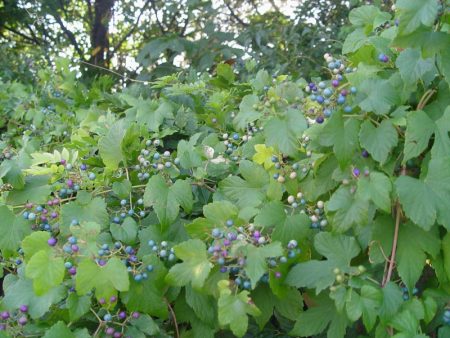
The vineyard belongs to the liana varieties and is often used to create landscape projects. It can be of two types: short-flowered and aconitolate. The first variety is grown only in areas with a warm climate, as it does not survive frosts. The akonolistny vineyard can be grown throughout the country, it tolerates winter well, its shoots do not freeze.
Both the one and the other species begin to bear fruit closer to the beginning of summer. Pale yellow berries form on the bushes. The fruits look especially beautiful against a bright green foliage background. From the end of summer to the fall, the color of the berries begins to change from yellow to blue. Leaves also change color from green to red.
Actinidia colomictus
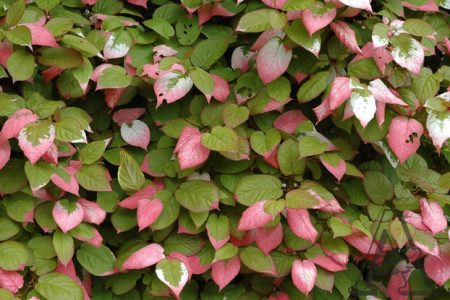
For cultivation in Siberia and the Urals, where winter is long and at low temperatures, the actinidium colomict is suitable for decorating the arbor.It represents a liana with a tree-like stem and thick green foliage. Foliage depending on the ambient temperature changes in color: the leaves can be not only green, but also yellow, red, pink and raspberry.
In the first summer months, the plant blooms, white beautiful inflorescences with a pleasant smell appear on the branches. In the second half of summer and autumn, green clusters of berries form on the vine, for which it is often confused with a vineyard. The berries are green-yellow in color and suitable for human consumption. Full ripening of fruits occurs only in the fall, the berries acquire a saturated green color. The flesh tastes sweet and sour, pleasant. Fruits are very useful for the human body, since their juice contains ascorbic acid, vitamins of groups A and B, D.
Fruiting actinidia occurs 4-5 years after the start of cultivation.
The height of the vine reaches 8-15 meters. It is suitable for landing on a shaded area, since actinidia does not like direct sunlight. Liana actively multiplies with the help of lateral shoots, so the plant needs pruning annually.
Honeysuckle Honeysuckle
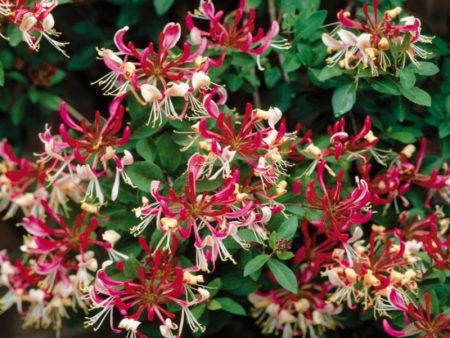
If you plan to create a hedge in the garden, then honeysuckle is suitable. The plant begins to bloom in the spring and summer. White flowers exude an amazing aroma that becomes especially pronounced in the evening. During flowering, honeysuckle bushes resemble an orchid due to bizarre large inflorescences. When flowering ends, red inedible berries appear on the sites of inflorescences.
Honeysuckle grows to one meter per year. The height of an adult plant reaches 5 meters. Honeysuckle is suitable for planting in any area; it exhibits high frost resistance and good immune qualities. Trimming of the lateral and upper branches is carried out 1-2 times a year, during the dormancy period of the shrub - in autumn and early spring.
Wisteria Blue Moon
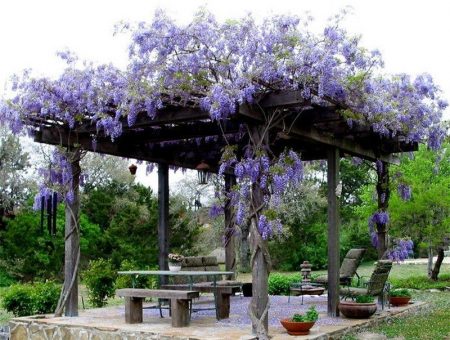
In its beauty, Wisteria Blue Moon has no equal. Bright gentle lilac clusters hanging from the branches of inflorescences give the vine a fabulous look. At night, inflorescences shimmer in silver. Flowers are collected in clusters, the length of which reaches from 20 to 30 centimeters. Green leaves on the vine are also collected in small groups of 6-9 pieces.
Wisteria color in the warm season, frost resistance The Blue Moon is considered the strongest, the plant is able to tolerate frosts to minus 40 degrees. The plant has a number of features for growing and caring:
- the need for bright sunlight at least 6 hours a day;
- infrequent watering;
- permanent removal of excess shoots;
- fear of drafts, the need for reliable shelter from the wind.
Adult shoots grow up to 8-10 meters in length, bend well and are suitable for decorating fences, arbors and balconies.
Climbing ivy
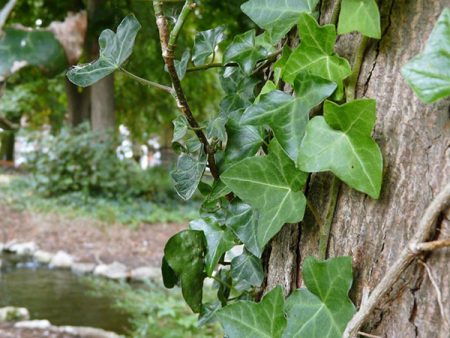
One of the most common climbing cultures in our country has still not lost its relevance. Ivy continues to be used to create hedges and decorate the facades of houses and arbors. Especially often it can be found in the Caucasus or in the Crimea.
Ivy is recognized as an evergreen perennial. Depending on the variety, the leaves are of different sizes, but the same shape. The shape of the leaf is five-fingered, young leaves may have rounded edges. The sheet plate is dense, smooth, green. In nature, there are other varieties of plants with brighter colors: red, pink, purple.
Shoots are able to grow to a height of 30 meters. Culture growth occurs with great intensity, in one year the plant grows several meters in length. Ivy blooms in early summer, but its inflorescences are of no value. Inflorescences consist of green-yellow flowers, which form a hat at the top.Flowers practically do not emit a smell.
Curly ivy is a thermophilic culture. It is not recommended to be grown in the northern regions, shoots can die during the winter. Otherwise, there are no special requirements for growing ivy. Young shoots take root well in any soil and quickly adapt to their surroundings, clinging to any support with aerial roots.
Clematis
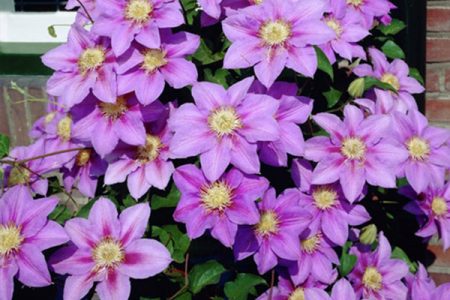
For lovers of small flowering vines, clematis is ideal. This flower is a real handsome man who does not leave indifferent to its bright colors. The buds that have blossomed during the summer season have a rich purple-pink, white, and lilac color. Flowers have 6-7 petals and a seed cup in the center, flowering time is high and is at least 3 months. Leaves are standard, green with a glossy finish. The height of adult clematis rarely exceeds 5 meters.
Clematis is considered a finicky vine. In order for it to bloom, it is necessary to properly and constantly care for it. Improper watering compliance, untimely and sparse pruning are often the reason that the vine does not bloom. Clematis is grown in warm climatic conditions; it does not accept a sharp temperature difference. Landing is done in a sunny place, without shading. You can not plant it close to the fences, this will provoke a lack of lighting.
For abundant flowering, clematis needs constant watering. The watering rate in the summer season is 1 time in 2 days, no less. Ground water should not stagnate. Even when planting in the southern regions, shoots need to be covered with agrofibre for the winter. With the onset of spring, shelter is removed, shoots are trimmed. From the beginning of May, clematis comes to life: green foliage forms on it again.
Water clematis only with warm water, ice water for irrigation is prohibited.
Schizandra
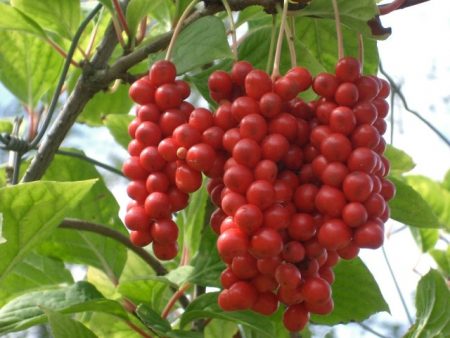
The second name is Chinese magnolia vine. Perennial liana grows up to 8 meters tall. The stems bend well, are able to entwine even greater support. The color of the leaves depends on the age of schizandra: in young vines, the foliage is painted in light green, and in adults - in dark green.
Chinese lemongrass bears fruit in the second half of summer with red berries about 1 centimeter long. They are clearly visible against the background of green foliage. Berries are famous for their healing properties, they are used in medicine to treat a number of diseases. Fruits have a choleretic effect, normalize the work of the gastrointestinal tract, improve metabolism in the body. The fruit has a specific taste that combines bitter and sweet.
Possessing good frost resistance, schizandra takes root and bears fruit in areas of the Far East, on Sakhalin. The plant is often grown not only for beauty, but also to collect valuable berries as a medicine.
Highlander Baljuan
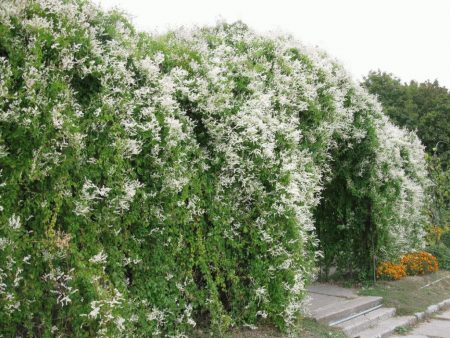
The plant is considered a powerful vine with an annual growth of at least 3-4 meters. In the summer season, white small flowers bloom on all shoots of the highlander in the upper part. The flowers are collected panicle inflorescences and look very attractive. Flowering continues until the end of autumn.
Highlander Baldzhuansky blooms only with sufficient lighting, so when planting plants determine it on the sunniest part. For the winter, the highlanders shelter. Even if part of the shoots froze slightly during the winter, it does not matter - the perennial is quickly restored in the spring. After some time, new branches form at the cutting sites.
Landing and caring for the mountaineer is not difficult. It perfectly takes root in a variety of soils, is not demanding on watering and grows by itself.
Climbing roses
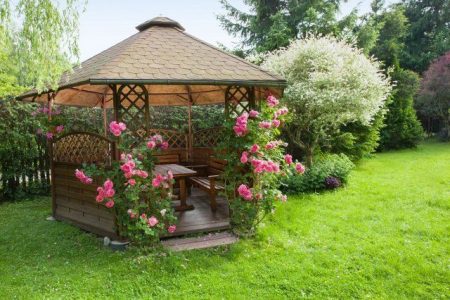
Royal flowers grow not only in flowerbeds and gardens, but also serve as decoration of arbors, fences and hedges. The beauty of roses is very difficult to compete with, their appearance captures the views of everyone around.A wide variety of varieties allows you to choose a wide variety of colors for planting, from plain, calm and ending with marble and bright colors. In addition, inflorescences differ in the shape of the buds and their size.
With proper cultivation, shoots of roses can grow up to 10 meters long. The shoots bend well, as their trunk is elastic, but strong. Caring for climbing roses is not so simple. The most important features of the flower include temperature conditions. The temperature should not fall below zero in the winter, otherwise the plants die. For winter, it is necessary to shelter all shoots with windproof fabric.
Water the flower as the soil dries, once a week, not more often. For better flowering, during dormancy, a rose is cut 2 times a year, most of the shoots are removed, and the remaining branches are shortened 2 times. With proper pruning, a constant rejuvenation of the bush occurs, so flowering lasts longer and more intensively.
Places to cut the shoots are immediately poured with garden varieties to prevent infection.
Hop
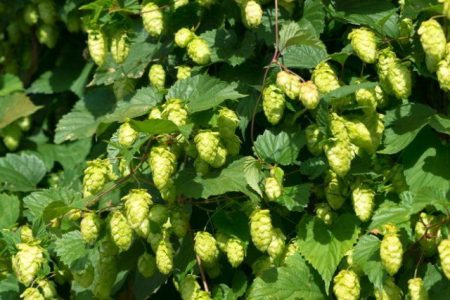
The herbaceous perennial has a characteristic feature: in the autumn the branches die off on their own, and in the spring the roots become active again and form new young shoots on the surface of the earth. The length of the adult plant is 6-7 meters. Evergreen hops in the summer produce light green cones. Hop cones are used in folk medicine to treat gynecological diseases and normalize blood pressure.
With hops there are no problems in growing. Shoots quite quickly capture new territories, and if they are not cut, they grow even where they are not needed. When pruning, remember that the juice inside the shoots is poisonous. Therefore, pruning is carried out with gloves. Hops need high humidity and warm temperatures, so the southern regions are considered optimal conditions for cultivation.
All of the above creepers are suitable for decorating gazebos, mesh netting and fences. Additional landscaping of already familiar objects not only performs a decorative function, but also protects against wind and oblique rain. Perennials will complement the site with a cozy atmosphere and a pleasant aroma of summer.




 Sow in the ground, without seedlings: 10 beautiful and unpretentious flowers
Sow in the ground, without seedlings: 10 beautiful and unpretentious flowers Platicodon planting and outdoor care
Platicodon planting and outdoor care Hosta - planting and care in the open ground in the Urals
Hosta - planting and care in the open ground in the Urals Oleander - care and growing at home
Oleander - care and growing at home